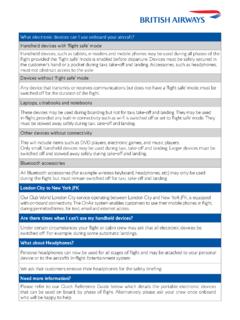Transcription of Why you shouldn't use set (and what you should …
1 Why you shouldn 't use set (and what you should use instead). Matt Austern Everything in the standard C++ library is there for a reason, but it isn't always obvious what that reason is. The standard isn't a tutorial; it doesn't distinguish between basic, everyday components and ones that are there only for rare and specialized purposes. One example is the Associative Container std::set (and its siblings map, multiset, and multimap). Sometimes it does make sense to use a set, but not as often as you might think. The standard library provides other tools for storing and looking up data, and often you can do just as well with a simpler, smaller, faster data structure.
2 What is a set? A set is an STL container that stores values and permits easy lookup. For example, you might have a set of strings: std::set<std::string> S;. you can add a new element by writing ("foo";. A set may not contain more than one element with the same key, so insert won't add anything if S already contains the string "foo"; instead it just looks up the old element. The return value includes a status code indicating whether or not the new element got inserted. As with all STL containers, you can step through all of the elements in a set using the set's iterators.)
3 (). returns an iterator that points to S's first element, and () returns an iterator that points immediately after S's last element. The elements of a set are always sorted in ascending order-which is why insert doesn't have an argument telling it where the new element is supposed to be put. The new element automatically gets inserted in the correct location. What it means for set to be an Associative Container is that you can look up a value, by writing i = ("foo");. If the lookup is successful then find returns an iterator that points to the appropriate element in the set.
4 If there is no such element then find returns the iterator (), which doesn't point to anything. What if you need the elements to be arranged in something other than ascending order, or if you're creating a set of elements for which "less than" isn't defined? In that case you can use set's second template parameter, a function object that determines which of two objects is supposed to come before the other. By default it is std::less<T>, meaning that the smaller element comes first. you can create a set of strings stored in reverse order, though, by using a different function object: std::set<std::string, std::greater<std::string> > S, or you can create a set of strings in case-insensitive order by writing your own function object1: struct less_nocase {.}
5 Static bool compare_chars(char x, char y) {. return std::toupper(x) < std::toupper(y);. }. bool operator()(const string& x, const string& y) const {. return std::lexicographical_compare( (), (), (), (), Compare_chars);. }. 1. Warning: Case-insensitive string comparison is more complicated than it looks, and this code is subtly wrong. In a future column I'll explain what's wrong with it, and how to rewrite it correctly. };. std::set<std::string, less_nocase> S;. Even more generally you can store some complicated data structure, and use only a piece of it for comparisons: struct Client {.
6 Unsigned long id;. string last_name, first_name;.. };. struct id_compare {. bool operator()(const Client& x, const Client& y) const {. return < ;. }. };. std::set<Client, id_compare> clients;. That's not all there is to set, of course. It has all the usual member functions of an STL container, and some special member functions of its own. The basic purpose, though, is managing a collection of elements that can be looked up by key. (The Associative Container map is very similar, except that in a set the elements are their own keys while in a map the elements are pairs; the first member of each pair is the key, and the second is some value that's associated with the key.)
7 What's wrong? Nothing is wrong, precisely-just incomplete. Contrary to appearances, I still haven't given any good reason why you would ever want to use a set. You don't need any special data structures or member functions to insert or look up elements, after all. If you've got any STL container C, you can find an element in it with the generic find algorithm: i = std::find( (), (), "foo");. Just like with the set::find member function, this will return an iterator that points to the element you're looking for, or () if there is no such element.
8 There's really only one important difference: std::find performs a linear search, so the time it takes is proportional to N (where N is the number of elements you're looking through), while the time taken by set::find is proportional to log N. That is, if N is large, set::find is much faster. The real point of set, and the other Associative Containers in the standard C++ library, is that they make specific performance guarantees: It's guaranteed that the time to find an element is proportional to log N, where N is the number of elements in the container, and also that the time to insert an element is proportional to log N.
9 There are also specific guarantees about exception safety and iterator invalidation; those guarantees, too, are sometimes important. If you don't need all of those properties, though, you'll be paying for something you don't use. A data structure that supports fast insertion and fast lookup is necessarily complicated; set is typically implemented as a red-black tree, which has substantial space and time overhead. Each element in a red-black tree requires more than three extra words of storage (a color marker, and pointers to two children and a parent).
10 Insertions require tree rebalancing, and lookup and iteration require pointer chasing. If you really need insertion and lookup in guaranteed log N time, then set is a sensible choice. If you don't, though, then you have other options. Suppose, for example, you're willing to relax the guarantee of insertion in log N time. That's not so unlikely; chances are you'll need to look things up much more often than you'll need to insert them. Red-black trees aren't the only way to organize data that permits lookup in logarithmic time.







